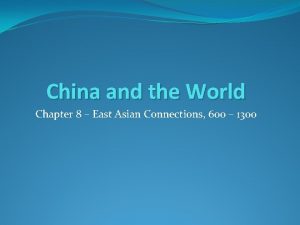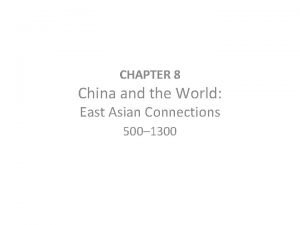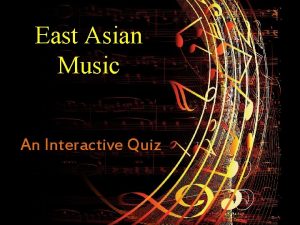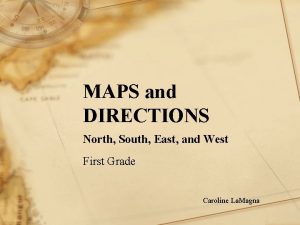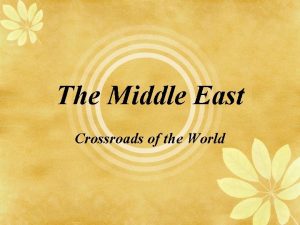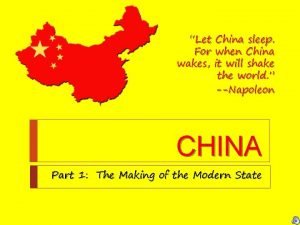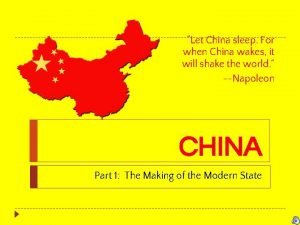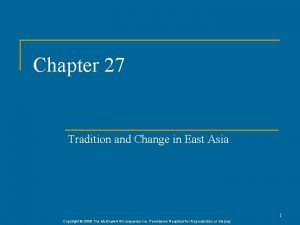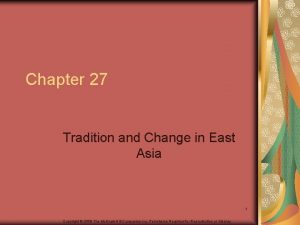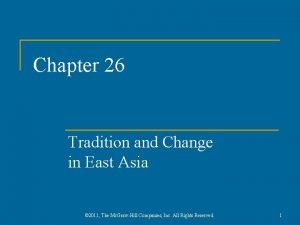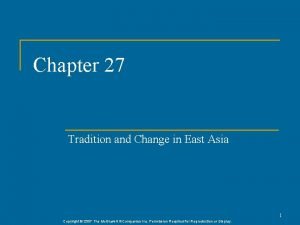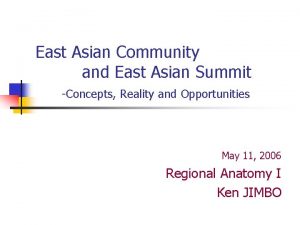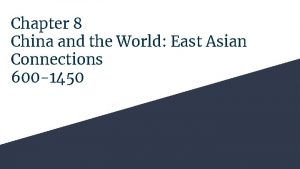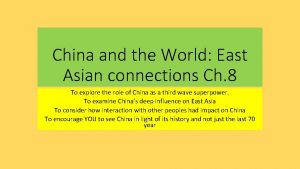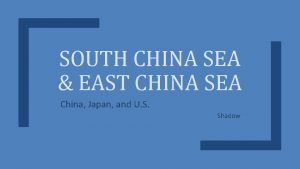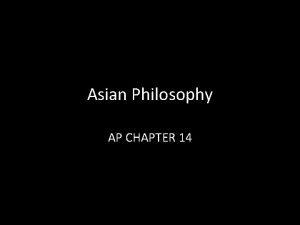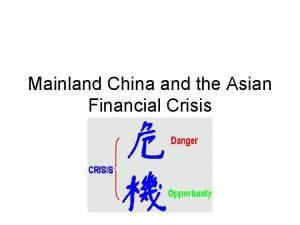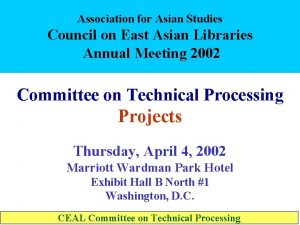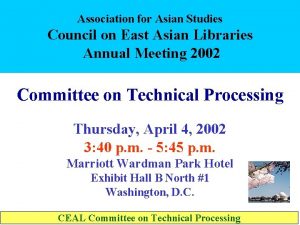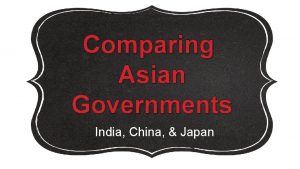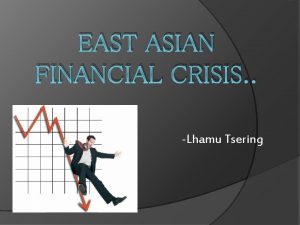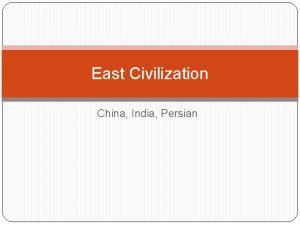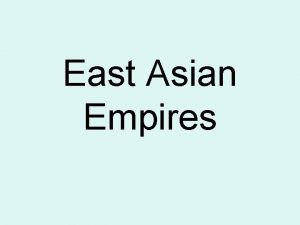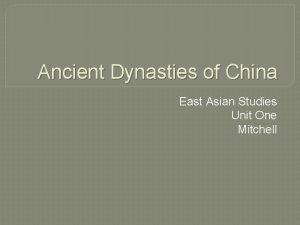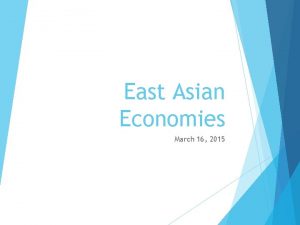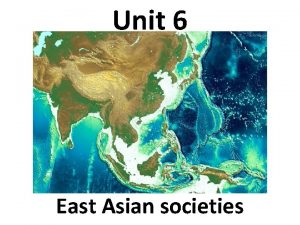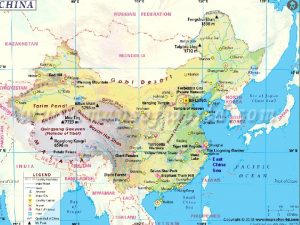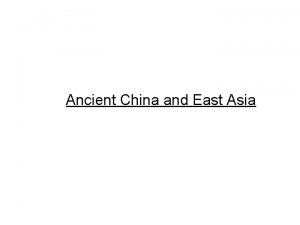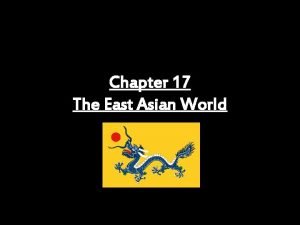China and the World Chapter 8 East Asian
































- Slides: 32

China and the World Chapter 8 – East Asian Connections, 600 – 1300

A Third Wave of Civilizations � 1. Early Civilizations – Mesopotamia, Indus Valley, Nile Valley; China along the Huang He: 3500 B. C. E. – 600 B. C. E. � 2. Classical Era – Greece, Rome, Persia, Maya: 600 B. C. E. – 600 C. E. � 3. Third Wave Civilizations: 600 – 1300.

China as a Major Player in the Third Wave Civilizations �China-centered “world order” encompassed most of eastern Asia. �China’s borders reached far into Central Asia. �It’s wealth and cosmopolitan culture attracted visitors from afar. �All of China’s neighbors felt its gravitational pull. �China’s booming economy and technological innovation had effects throughout Eurasia.

The Re-emergence of a Unified China �The Han dynasty collapsed in 220 C. E. �Political fragmentation for over 300 years. �Sui, Tang, and Song Dynasties emerged from 589 -1279. �Sui Dynasty (589 -618) – reunified China: -extend canal system, large government projects. -ruthlessness and failure to conquer Korea discredited the dynasty and exhausted state resources.

A “Golden Age” of Chinese Achievement �The Tang dynasty (618 -907) and Song dynasty (9601207) built on renewed unity. �The “Golden Age” of Chinese Arts and Literature: -poetry, landscape painting; ceramics of high order. �Birth of Neo-Confucianism (during Song dynasty): -revival of Confucian thinking with added insights of Buddhism and Daoism. �Politics: -civil service exams revived (printing press invented). -many more universities opened. -large landowners still powerful despite state efforts to re-distribute land.

A Cheat Sheet Used on Chinese Civil Service Exam

A “Golden Age” of Chinese Achievement (Cont’d) �Economic revolution under the Song dynasty. �Population growth: 50 million – 120 million by 1200. -Capital city, Hangzhou, had over 1 million people. �Improvements in agricultural production, iron production, waterways, and factories. �Best shipbuilding in the world. � 3 famous inventions: -compass, gunpowder, and printing press.

Chinese “Junk Ship” and Columbus’ Ships in Comparison

Chinese Inventions

A “Golden Age” of Chinese Achievement (Cont’d) �Cheap transportation allowed peasants to grow specialized crops for commercial markets. �Government demanded payment of taxes in cash, not in goods. �Growing use of paper money and financial instruments – contributed to the commercialization of Chinese society.

Women in the Song Dynasty �Not a very “golden” age for women. �More restrictions on women with a Confucianist revival and economic growth (patriarchy). �Foot binding became popular in the 11 th century: -new images of beauty; women restricted to the house. �Wealthy elite class – concubines. �Changing job opportunities: with the commercialization of weaving, many were pushed out of the textile labor force. �Women became educated to better raise their sons, and their property rights expanded.

Foot Binding

China and the Northern Nomads �Misconceptions: -China was “self contained. ” -China was “unchanging. ” �Nomads of the north: -nomads were in kinship groups. -occasional confederations or powerful states. -special pastoral societies needed grain from China. -leaders wanted luxury goods (silk) from China. -nomads threatened by Chinese attacks (Great Wall). -China needed nomads – horses; access to silk roads.

Map of China

The Tribute System in Theory �China’s “middle kingdom” – conceited superiority. �Chinese believed that they could “civilize” the nomads. �Tribute system – extortion: -foreigners were expected to send tribute missions of ceremonial gifts to the capital and perform the kowtow to show their recognition of China’s superiority. -for China, this was a way to manage inferior barbarians on the periphery.

The Tribute System in Practice �In reality, China was vulnerable to nomadic raids. At times, they not only raided but also conquered parts of China. �“Gifts” to Xiongnu and Turkic nomads: the Chinese paid protection to these raiders with large gifts of wine, silk, and grain. This allowed the Chinese court to maintain the fiction of its invulnerability. �Nonetheless, in times of weakness, China remained vulnerable.

Image of Tribute

Cultural Influence across an Ecological Frontier �While some aspects of Chinese culture made their way north, Chinese-style agriculture and material life was impossible in Central Asia. �In contrast, the indigenous people of southern China were almost completely absorbed into the great Chinese cultural world. �As both the Tang and Song dynasties had their origins in mixed Sino-Turkic families, there was a great influence in the court. �For some time in the Tang dynasty, there was a fad for things from the west such as: music, fashion, religion, and dancing. �The southern Chinese, who saw themselves as the heirs to the Han, were extremely critical of foreign fads.

Korea and China �China had a tribute system established with Korea after a period of colonization and invasions. -China provided legitimacy for Korean rulers. -Efforts to replicate Chinese court life and administration (Tang China). -Capital city Kumsong modeled on Chinese capital Chang’an. �Acceptance of Chinese culture: -Confucianism ended “equality” for women. -Korea maintained much of its culture.

Map of Korea

Vietnam and China �Parts of Vietnam were incorporated into China. �Serious effort to assimilate the Vietnamese: -provoked periodic rebellions. �Vietnamese rulers adopted the Chinese approach to government: -examination system helped undermine established aristocrats. -elite remained deeply committed to Chinese culture. -remained a tributary vassal state. �Much of distinctive Vietnamese culture remained in place: -language, cockfighting, and greater roles for women.

Map of Vietnam

Cockfighting

Japan and China �Never invaded or conquered by China. �Voluntary borrowing of culture: -large envoys sent to China. �Elements of Chinese culture took root in Japan -several schools of Chinese Buddhism. -art, architecture, education, medicine; religious views. -Chinese writing system. �Japanese borrowings were selective: -deliberate borrowings stopped after the tenth century.

Japan and China (Cont’d) �Japan does not become centralized like China: -political power became decentralized. -local authorities developed (samurais). �Japan kept its unique religious identity: -Buddhism never replaced Shintoism (spirit and ancestor worship). �Women escaped the oppressive elements of Chinese Confucian culture: -women wrote in the vernacular (everyday language).

Map of Japan

Spillovers: China’s Impact on Eurasia �Chinese advances spread to Europe: -salt production through solar evaporation. -papermaking. -printing (though resisted by the Islamic world). -gunpowder invented, ca. 1000, but used differently after it reached Europe. -Chinese textile, metallurgical, and naval technologies. -stimulated imitation and innovation (magnetic compass).

On the Receiving End: China as Economic Beneficiary �Learned cotton and sugar cultivation and processing from India. �Writing was stimulated by Buddhism. �China in Indian Ocean Trade: -foreign merchant settlements in southern Chinese ports during the Tang dynasty. -occasional violence, for example, massacre of foreigners in Canton in the 870 s. -transformation of southern China to production for export instead of subsistence.

Making Buddhism Chinese �Buddhism was India’s most important gift to China. �At first, Buddhism had little appeal in China: -Buddhist monasticism seemed to dishonor Chinese family values. -concern for individual salvation seemed selfish. �Collapse of the Han dynasty in 220 C. E. brought chaos and a discrediting of Confucianism, which paved the way for alternative understandings of the world.

Making Buddhism Chinese (Cont’d) �Nomadic rulers in northern China favored Buddhism. �Monasteries provided an increasing array of social services. �Buddhists appeared to have access to magical powers. �Serious effort to present Buddhism in a form accessible to the Chinese: -dharma was translated as dao. -“morality” was translated as filial submission. -it was the Mahayana form of Buddhism which became popular.

Spread of Buddhism

Losing State Support: The Crisis of Chinese Buddhism �Lushan rebellion (755 -763) created xenophobia. �Direct action against Buddhism in China: -Buddhism challenges Confucianism (celibacy of monks and Confucian-based family system). -thousands of monasteries, temples, and shrines were confiscated or destroyed. -Buddhists forbidden to use precious metals or gems for their images. �Buddhism did not vanish from China, it remained an important element of popular religion.
 Chapter 8 china and the world east asian connections
Chapter 8 china and the world east asian connections Chapter 8 china and the world east asian connections
Chapter 8 china and the world east asian connections What meter is used in the japanese song sakura
What meter is used in the japanese song sakura Southeast asian ministers of education organization
Southeast asian ministers of education organization Relative location of southwest asia
Relative location of southwest asia East is east and west is west
East is east and west is west What is asias largest desert
What is asias largest desert Ecupl
Ecupl Pacific islander inventions
Pacific islander inventions What is the horizontal movement of air called
What is the horizontal movement of air called Laissez faire theory
Laissez faire theory Ap world history chapter 25 africa and the atlantic world
Ap world history chapter 25 africa and the atlantic world Maps.google.comps
Maps.google.comps Crossroads of the world middle east
Crossroads of the world middle east Communism in china ap world history
Communism in china ap world history Why didn't china discover the new world
Why didn't china discover the new world Let china sleep quote
Let china sleep quote Let china sleep
Let china sleep What is a key stone species
What is a key stone species Black and asian counselling network
Black and asian counselling network Chapter 27 tradition and change in east asia
Chapter 27 tradition and change in east asia Chapter 27 tradition and change in east asia
Chapter 27 tradition and change in east asia Chapter 26 tradition and change in east asia
Chapter 26 tradition and change in east asia Chapter 27 tradition and change in east asia
Chapter 27 tradition and change in east asia Hình ảnh bộ gõ cơ thể búng tay
Hình ảnh bộ gõ cơ thể búng tay Bổ thể
Bổ thể Tỉ lệ cơ thể trẻ em
Tỉ lệ cơ thể trẻ em Chó sói
Chó sói Tư thế worm breton là gì
Tư thế worm breton là gì Chúa yêu trần thế alleluia
Chúa yêu trần thế alleluia Môn thể thao bắt đầu bằng từ đua
Môn thể thao bắt đầu bằng từ đua Thế nào là hệ số cao nhất
Thế nào là hệ số cao nhất
